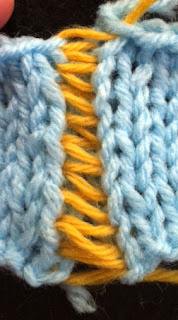 |
| Tassel on the left was made with some wool yarn I dyed myself. Tassel on the right was made with Sugar n Cream cotton yarn. |
Tassels are easy to make. You don't need any fancy equipment, either.
You will need:
- A piece of cardboard or something else you can wrap your yarn around. It should be a little longer than you want your finished tassel to be. That way you can trim up the end without having a shorter than desired tassel. (I used a piece of folded cardboard to make mine, as you will see in the video, but you needn't fold yours. )
- Scissors
- Crochet hook
- Yarn, of course
To keep things brief here, I am not going to go into great written detail. Not that it is complicated to make a tassel, but it is much easier to see it being done than read how to do it. Basically, all you do is wrap your yarn around the cardboard, until the tassel is as thick as you want it. The more wraps you do, the thicker your tassel will be. Then, cut a length of yarn, slip your crochet hook under the wraps, pull the length of yarn under them, and tie it a couple of times tightly so that the tassel doesn't come apart. These are the strands you will use to attach the tassel to your project. Next, cut the wraps on the opposite end from where you tied them together. The tassel can be used as is, or you can cut another length of yarn, and tie it around the tassel a short distance from the top. You can see in the picture above where I have tied my tassels. I like to wrap my yarn a few times around the tassel, but you can just tie and be done. With your crochet hook, pull the tails from the yarn you used to tie around the tassel underneath itself and voila. Trim if necessary. To attach your tassel to a hat or scarf, or whatever you like, just use the strands from the top of the tassel to tie them on. That's it.
So, here is the video. Happy Tasseling!












